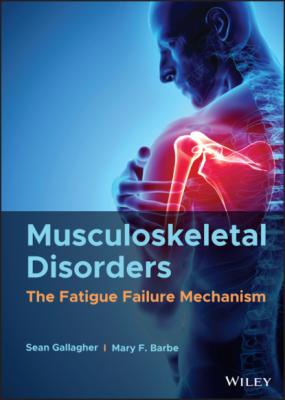ТОП просматриваемых книг сайта:
Musculoskeletal Disorders. Sean Gallagher
Читать онлайн.Название Musculoskeletal Disorders
Год выпуска 0
isbn 9781119640134
Автор произведения Sean Gallagher
Жанр Здоровье
Издательство John Wiley & Sons Limited
42 Iannarone, V. J., Cruz, G. E., Hilliard, B. A., & Barbe, M. F. (2019). The answer depends on the question: Optimal conditions for western blot characterization of muscle collagen type 1 depends on desired isoform. Journal of Biological Methods, 6(3), e117. https://doi.org/10.14440/jbm.2019.289
43 Ishikawa, H. (1966). Electron microscopic observations of satellite cells with special reference to the development of mammalian skeletal muscles. Zeitschrift für Anatomie und Entwicklungsgeschichte, 125(1), 43–63. Retrieved from http://www.ncbi.nlm.nih.gov/pubmed/5973580
44 Jiang, J. X., Siller‐Jackson, A. J., & Burra, S. (2007). Roles of gap junctions and hemichannels in bone cell functions and in signal transmission of mechanical stress. Frontiers in Bioscience, 12, 1450–1462. Retrieved from http://www.ncbi.nlm.nih.gov/pubmed/17127393
45 Joyner, M. J., & Casey, D. P. (2015). Regulation of increased blood flow (hyperemia) to muscles during exercise: A hierarchy of competing physiological needs. Physiological Reviews, 95(2), 549–601. https://doi.org/10.1152/physrev.00035.2013
46 Jozsa, L., & Kannus, P. (1997). Histopathological findings in spontaneous tendon ruptures. Scandinavian Journal of Medicine and Science in Sports, 7(2), 113–118. Retrieved from http://www.ncbi.nlm.nih.gov/pubmed/9211612
47 Junqueira, L. C., & Carneiro, J. (2005). Basic histology text and atlas (11th ed.). McGraw‐Hill.
48 Kannus, P. (2000). Structure of the tendon connective tissue. Scandinavian Journal of Medicine and Science in Sports, 10(6), 312–320. Retrieved from http://www.ncbi.nlm.nih.gov/pubmed/11085557
49 Ker, R. F. (2002). The implications of the adaptable fatigue quality of tendons for their construction, repair and function. Comparative Biochemistry and Physiology Part A: Molecular and Integrative Physiology, 133(4), 987–1000. https://doi.org/10.1016/s1095‐6433(02)00171‐x
50 Khurana, J. S. (Ed.) (2009). Bone pathology (2nd ed.). Humana Press.
51 Kietrys, D. M., Barr, A. E., & Barbe, M. F. (2011). Exposure to repetitive tasks induces motor changes related to skill acquisition and inflammation in rats. Journal of Motor Behavior, 43(6), 465–476. https://doi.org/10.1080/00222895.2011.627897
52 Kjaer, M. (2004). Role of extracellular matrix in adaptation of tendon and skeletal muscle to mechanical loading. Physiological Reviews, 84(2), 649–698. https://doi.org/10.1152/physrev.00031.2003
53 Klein‐Nulend, J., Bacabac, R. G., & Bakker, A. D. (2012). Mechanical loading and how it affects bone cells: the role of the osteocyte cytoskeleton in maintaining our skeleton. Eur Cell Mater, 24, 278–291. Retrieved from http://www.ncbi.nlm.nih.gov/pubmed/23007912
54 Klein‐Nulend, J., & Bonewald, L. F. (2008). The osteocyte. In J. P. Bilezikian, L. G. Raisz, & T. J. Martin (Eds.), Principles of bone biology (3rd ed., pp. 153–174). Academic Press, ISBN 9780123738844, doi: https://doi.org/10.1016/B978‐0‐12‐373884‐4.00028‐8
55 Kusters, Y. H., & Barrett, E. J. (2016). Liraglutide prevents microvascular insulin resistance and preserves muscle capillary density in high‐fat diet‐fed rats. American Journal of Physiology‐Endocrinology and Metabolism, 311(3), E640‐8. https://doi.org/10.1152/ajpendo.00205.2016
56 Li, Y., Wu, T., & Liu, S. (2021). Identification and distinction of tenocytes and tendon‐derived stem cells. Frontiers in Cell and Developmental Biology, 9, 629515.
57 Lian, J. B., & Stein, G. S. (2008). Osteoblast biology. In D. Feldman, D. A. Nelson, & C. J. R. R. Marcus (Eds.), Osteoporosis (3rd ed.). Elseivier Inc.
58 Listrat, A., Lethias, C., Hocquette, J. F., Renand, G., Menissier, F., Geay, Y., & Picard, B. (2000). Age‐related changes and location of types I, III, XII and XIV collagen during development of skeletal muscles from genetically different animals. The Histochemical Journal, 32(6), 349–356. Retrieved from http://www.ncbi.nlm.nih.gov/pubmed/10943849
59 Lynch, M. P., Stein, J. L., Stein, G. S., & Lian, J. B. (1995). The influence of type I collagen on the development and maintenance of the osteoblast phenotype in primary and passaged rat calvarial osteoblasts: Modification of expression of genes supporting cell growth, adhesion, and extracellular matrix mineralization. Experimental Cell Research, 216(1), 35–45. https://doi.org/10.1006/excr.1995.1005
60 Majeska, R. J., Ryaby, J. T., & Einhorn, T. A. (1994). Direct modulation of osteoblastic activity with estrogen. The Journal of Bone and Joint Surgery, 76(5), 713–721. Retrieved from http://www.ncbi.nlm.nih.gov/pubmed/8175820
61 Malaval, L., Modrowski, D., Gupta, A. K., & Aubin, J. E. (1994). Cellular expression of bone‐related proteins during in vitro osteogenesis in rat bone marrow stromal cell cultures. Journal of Cellular Physiology, 158(3), 555–572. https://doi.org/10.1002/jcp.1041580322
62 Mansour, J. M. (2009). Biomechanics of cartilage. In C. Hughes (Ed.), Kinesiology: The mechanics and pathomechanics of human movement (2nd ed., pp. 66–79). Baltimore: Lippincott Williams & Wilkins.
63 Marvulli, D., Volpin, D., & Bressan, G. M. (1996). Spatial and temporal changes of type VI collagen expression during mouse development. Developmental dynamics: An official Publication of the American Association of Anatomists, 206(4), 447–454. https://doi.org/10.1002/(SICI)1097‐0177(199608)206:4<447::AID‐AJA10>3.0.CO;2‐U
64 Mauro, A. (1961). Satellite cell of skeletal muscle fibers. Journal of Biophysical and Biochemical cytology, 9, 493–495. Retrieved from http://www.ncbi.nlm.nih.gov/pubmed/13768451
65 Miller, S. C., de Saint‐Georges, L., Bowman, B. M., & Jee, W. S. (1989). Bone lining cells: Structure and function. Scanning Microsc, 3(3), 953–960. discussion 960‐951. Retrieved from http://www.ncbi.nlm.nih.gov/pubmed/2694361
66 Mukund, K., & Subramaniam, S. (2019). Skeletal muscle: A review of molecular structure and function, in health and disease. Wiley Interdisciplinary Reviews: Systems Biology and Medicine, 12, e1462. Wiley
67 Murphy, W. L., Black, J., & Hastings, G. W. (2016). Handbook of biomaterial properties (2nd ed.). New York: Springer.
68 Nakashima, T., Hayashi, M., Fukunaga, T., Kurata, K., Oh‐Hora, M., Feng, J. Q., … Takayanagi, H. (2011). Evidence for osteocyte regulation of bone homeostasis through RANKL expression. Nature Medicine, 17(10), 1231–1234. https://doi.org/10.1038/nm.2452
69 Nakashima,

